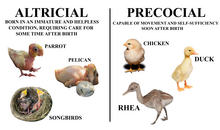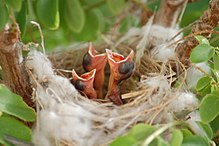Precociality and altriciality

In the study of biology of birds and mammals, some babies are born needing a lot of care because they can't move much. These babies are called altricial. Others are ready to move and do things on their own soon after they are born. These babies are called precocial. Precocial babies are often ready to leave their home (like a nest) very soon after they are born or hatched.
In fish, the difference is about if a baby fish is born with a stomach ready to digest food. Precocial fish babies have a stomach from the start, but altricial fish babies do not.[1]


Altricial[change | change source]
Altricial babies are not ready to do much when they are born. They need their parents to feed them and keep them safe for a while.
Where the word comes from[change | change source]
The word "altricial" comes from a Latin word that means "to feed". This is because these babies need to be fed by their parents.
Precocial[change | change source]
Precocial babies are more ready to take care of themselves soon after they are born or hatched.
Where the word comes from[change | change source]
"Precocial" comes from a word that means "early ripening" in Latin.
Why it matters[change | change source]
The difference between altricial and precocial babies matters because it affects how the animals live, how they are cared for by their parents, and how they survive in the wild.
Examples[change | change source]
- Altricial: human babies, kittens, and puppies.
- Precocial: ducklings, chicks of many ground-nesting birds, and many mammals like deer.
There are many kinds of animals between these two types.
References[change | change source]
- ↑ Rønnestad, Ivar; Yúfera, Manuel; Ueberschär, Bernd; Ribeiro, Laura; Saele, Øystein; Boglione, Clara (May 2013). "How baby fish eat and grow: what we know and what we don't". Reviews in Aquaculture. 5: S59–S98. doi:10.1111/raq.12010. hdl:2108/99721.
